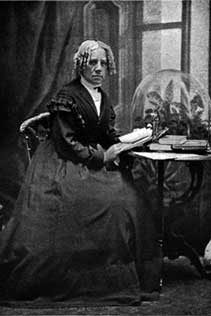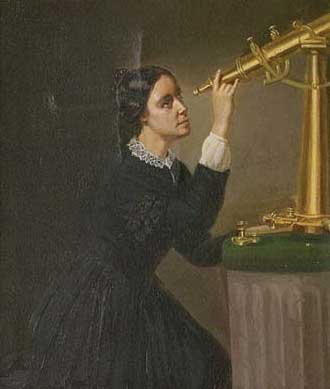Mamata Pandya
As we continue to celebrate women and girls in science, here is an inspiring story that goes back 200 years.
The common belief in 19th century American society was that too much intellectual education would damage a woman’s health, and that too much thought would fracture or destroy the weaker among them. Women were expected to spend their time in household chores and needlework; in their role as dutiful wives and mothers.

In 1818, a daughter was born to William and Lydia Mitchell. They named her Maria. The Mitchells lived on Nantucket Island, a community of seafarers. The family were Quakers. Quakers had beliefs and lifestyle different from the mainstream population; one of the tenets of their religion was intellectual equality between the sexes. They valued education and believed that the same quality of education should be given to boys as well as girls. Maria, one of ten children, was encouraged from a young age to exercise the power of her mind.
Maria began attending private elementary school at the age of four. When she was nine Maria joined a school that her father had established. Maria’s father was an unconventional teacher who believed in hands-on education and learning-by-doing. Students learnt about the natural world by being outdoors and direct observation and collection of natural objects. This approach to scientific study had a profound effect on Maria, who throughout her life inculcated the same process of exploration, investigation, and persistence.
Maria’s father was also an amateur astronomer who played an important role in the seafaring community of whalers and fishermen. There were no sophisticated and accurate devices then and the community relied entirely on the stars and the compass for nautical navigation. William Mitchell, with his interest in astronomy and daily roof top observations and astronomical recording, was the person they all consulted to check the accuracy of their charts, sextants, and chronometers.
From an early age Maria developed a love for astronomy and learnt much from her father’s instruction on astronomy, mathematics, surveying, and navigation. When she was 14 the whaling captains entrusted Maria to rate their chronometers on her own. Maria continued to pursue what was becoming a passion, with basic equipment from the small attic of their home.
When her father’s school wound up, Maria joined Cyrus Pierce’s School for Young Ladies. With a uniform curriculum for boys and girls and a nonauthoritarian outlook it was an unconventional school for its time. Cyrus Pierce was one of the first people outside of Maria’s own family to recognize her sharp mind, facility for mathematics and self-discipline. He encouraged and supported Maria in her intellectual journey. Later she worked for Pierce as his teaching assistant before she opened her own school in 1835. In a bold step at a time when schools were still segregated, she opened her school to non-white children. One year later, she was offered a job as the first librarian of the Nantucket Atheneum. A library, with a circulating collection of books, it also hosted meetings and lectures, and exhibited small collections of whaling and South Seas artifacts brought home by Nantucket mariners. She worked at the Antheneum for 20 years while continuing to pursue her astronomy studies.

On 1 October 1847, while the rest of the family was having a party, Maria was scanning the skies from the roof of the bank where her father then worked. She spotted a blurry object that was not shown on any of the charts. She told her father that she had discovered a new comet. Her father was keen that the discovery be made public, but Maria was hesitant because she feared that the scientific community would not take seriously a discovery made by a woman. William was determined and wrote to the noted astronomers of the day. But he was met with scepticism. He then came to know that Frederick VI, the King of Denmark, himself an amateur astronomer, was offering a gold medal to the first observer to spot a new telescopic comet. After a prolonged effort to get Maria’s discovery recognized, she was awarded the gold medal over a year later. The new comet was given the official name Comet 1847-VI, but is commonly known as “Miss Mitchell’s Comet”.
Maria Mitchell’s discovery was recognized in a largely male-dominated field. In 1848 she was elected as the first female member of the American Academy of Arts and Sciences, and was one of the first women members of the American Philosophical Society. She also became one of the first women to work for the US Federal Government as part of the US Nautical Almanac. She continued her post as librarian even as she took on new roles and responsibilities in the world of science.
In 1856, she resigned her post at the Atheneum to travel to Europe as the chaperone of the daughter of a rich businessman. She took the opportunity to meet scientists and visit observatories, but also found that even in Europe biases against women scientists were well entrenched. For example, she was not allowed to observe the stars through the Pope’s telescope because she was a woman.
In 1865, Mathew Vassar, a wealthy and enlightened man, started the Vassar College. This was the second women’s college in America and was unusually progressive in many respects, including being the first to hire women as professors. Mathew Vassar saw Maria as a role model for intelligent and ambitious young women and hired her as the first professor to teach at Vassar, even as he faced a lot of opposition. Maria taught at the college for 23 years. Though she was by far the most popular professor she was initially paid only one-third the salary of the male professors. She was also constantly subjected to the deep-rooted prejudice of women being unsuitable for mathematical and scientific pursuits.
As a teacher, Maria followed her father’s approach of hands-on learning, taking her students on study trips to observe and record. She infused her students with a sense of excitement and a hunger for knowledge, while sowing the seeds of respect for the scientific method and temperament. She followed unconventional teaching practices; she slept in the same dormitory as her students and would often wake them to observe the night sky. Then she would invite them to her room to drink coffee and discuss astronomy.
On nights when the sky was too cloudy for observations, she would invite the students to the observatory for a social get together. As they entered, she would personally hand out a scroll to each student, with a poem that she had specially written for that student. Then they would go around the room reading each person’s poem in turn. This tradition of ’Dome Parties’ continues to this day at Vassar.
Thus, Maria became more than a teacher for her students; she was guardian, mentor, and surrogate mother. But she expected much from her students, especially a dedication to accuracy and scientific temper, just as she had been taught by her father. She treated her students as equals; as she told her class that “We are women studying together.” Above all she paved the way for women in science with these words to her first class of female astronomers at Vassar in 1876: “No woman should say, ‘I am but a woman!’ But a woman! What more can you ask to be?”
Maria Mitchell retired from her teaching post in 1888, after a long and distinguished career as the first professional female astronomer in America. She died a year later in 1889.
Maria Mitchell was more than just a trailblazer in astronomy. She was deeply involved in the emerging movement for woman’s rights to vote, own property, and receive the same type of education and opportunities offered to men. She was one of the founders of the Association for the Advancement of Women in 1873. She proved to the world that women, especially 19th century women, could do much more than just embroider samplers or oversee the household help. As she wrote, “The eye that directs a needle in the delicate meshes of embroidery, will equally well bisect a star with the spider web of a micrometer.”
The trail that Maria laid continues to open further every day. In February 2021, the European Space Agency put out a call for new astronaut candidates, the first time in 11 years, strongly encouraging women to apply for a place on the new team. The sky is certainly not the limit!
The author worked at the Centre for Environment Education in Ahmedabad for over three decades, where she was engaged in instructional design for educators and children. She is now an independent consultant, editor, writer, translator, storyteller and blogger. She can be reached at mamata.pandya@gmail.com.
